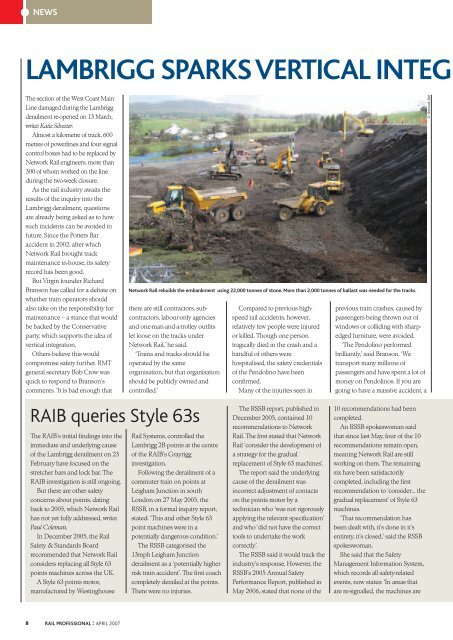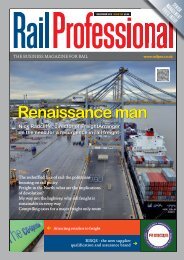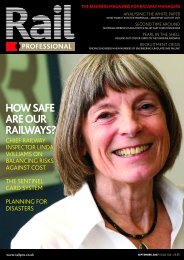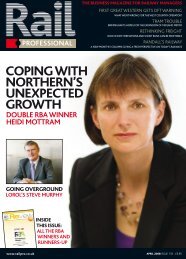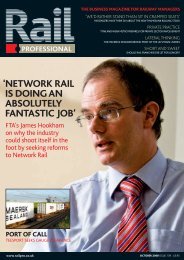'THE GOVERNMENT'S ABSOLUTELY AWARE ... - Rail Professional
'THE GOVERNMENT'S ABSOLUTELY AWARE ... - Rail Professional
'THE GOVERNMENT'S ABSOLUTELY AWARE ... - Rail Professional
You also want an ePaper? Increase the reach of your titles
YUMPU automatically turns print PDFs into web optimized ePapers that Google loves.
NEWS<br />
LAMBRIGG SPARKS VERTICAL INTEGR<br />
The section of the West Coast Main<br />
Line damaged during the Lambrigg<br />
derailment re-opened on 13 March,<br />
writes Katie Silvester.<br />
Almost a kilometre of track, 600<br />
metres of powerlines and four signal<br />
control boxes had to be replaced by<br />
Network <strong>Rail</strong> engineers, more than<br />
300 of whom worked on the line<br />
during the two-week closure.<br />
As the rail industry awaits the<br />
results of the inquiry into the<br />
Lambrigg derailment, questions<br />
are already being asked as to how<br />
such incidents can be avoided in<br />
future. Since the Potters Bar<br />
accident in 2002, after which<br />
Network <strong>Rail</strong> brought track<br />
maintenance in-house, its safety<br />
record has been good.<br />
But Virgin founder Richard<br />
Branson has called for a debate on<br />
whether train operators should<br />
also take on the responsibility for<br />
maintenance – a stance that would<br />
be backed by the Conservative<br />
party, which supports the idea of<br />
vertical integration.<br />
Others believe this would<br />
compromise safety further. RMT<br />
general secretary Bob Crow was<br />
quick to respond to Branson’s<br />
comments. ‘It is bad enough that<br />
there are still contractors, subcontractors,<br />
labour-only agencies<br />
and one-man-and-a-trolley outfits<br />
let loose on the tracks under<br />
Network <strong>Rail</strong>,’ he said.<br />
‘Trains and tracks should be<br />
operated by the same<br />
organisation, but that organisation<br />
should be publicly owned and<br />
controlled.’<br />
RAIB queries Style 63s<br />
The RAIB’s initial findings into the<br />
immediate and underlying cause<br />
of the Lambrigg derailment on 23<br />
February have focused on the<br />
stretcher bars and lock bar. The<br />
RAIB investigation is still ongoing.<br />
But there are other safety<br />
concerns about points, dating<br />
back to 2005, which Network <strong>Rail</strong><br />
has not yet fully addressed, writes<br />
Paul Coleman.<br />
In December 2005, the <strong>Rail</strong><br />
Safety & Standards Board<br />
recommended that Network <strong>Rail</strong><br />
considers replacing all Style 63<br />
points machines across the UK.<br />
A Style 63 points motor,<br />
manufactured by Westinghouse<br />
Network <strong>Rail</strong> rebuilds the embankment using 22,000 tonnes of stone. More than 2,000 tonnes of ballast was needed for the tracks.<br />
<strong>Rail</strong> Systems, controlled the<br />
Lambrigg 2B points at the centre<br />
of the RAIB’s Grayrigg<br />
investigation.<br />
Following the derailment of a<br />
commuter train on points at<br />
Leigham Junction in south<br />
London on 27 May 2005, the<br />
RSSB, in a formal inquiry report,<br />
stated: ‘This and other Style 63<br />
point machines were in a<br />
potentially dangerous condition.’<br />
The RSSB categorised the<br />
13mph Leigham Junction<br />
derailment as a ‘potentially higher<br />
risk train accident’. The first coach<br />
completely derailed at the points.<br />
There were no injuries.<br />
Compared to previous highspeed<br />
rail accidents, however,<br />
relatively few people were injured<br />
or killed. Though one person<br />
tragically died in the crash and a<br />
handful of others were<br />
hospitalised, the safety credentials<br />
of the Pendolino have been<br />
confirmed.<br />
Many of the injuries seen in<br />
The RSSB report, published in<br />
December 2005, contained 10<br />
recommendations to Network<br />
<strong>Rail</strong>. The first stated that Network<br />
<strong>Rail</strong> ‘consider the development of<br />
a strategy for the gradual<br />
replacement of Style 63 machines’.<br />
The report said the underlying<br />
cause of the derailment was<br />
incorrect adjustment of contacts<br />
on the points motor by a<br />
technician who ‘was not rigorously<br />
applying the relevant specification’<br />
and who ‘did not have the correct<br />
tools to undertake the work<br />
correctly’.<br />
The RSSB said it would track the<br />
industry’s response. However, the<br />
RSSB’s 2005 Annual Safety<br />
Performance Report, published in<br />
May 2006, stated that none of the<br />
previous train crashes, caused by<br />
passengers being thrown out of<br />
windows or colliding with sharpedged<br />
furniture, were avoided.<br />
‘The Pendolino performed<br />
brilliantly,’ said Branson. ‘We<br />
transport many millions of<br />
passengers and have spent a lot of<br />
money on Pendolinos. If you are<br />
going to have a massive accident, a<br />
10 recommendations had been<br />
completed.<br />
An RSSB spokeswoman said<br />
that since last May, four of the 10<br />
recommendations remain open,<br />
meaning Network <strong>Rail</strong> are still<br />
working on them. The remaining<br />
six have been satisfactorily<br />
completed, including the first<br />
recommendation to ‘consider… the<br />
gradual replacement’ of Style 63<br />
machines.<br />
‘That recommendation has<br />
been dealt with, it’s done in it’s<br />
entirety, it’s closed,’ said the RSSB<br />
spokeswoman.<br />
She said that the Safety<br />
Management Information System,<br />
which records all safety-related<br />
events, now states: ‘In areas that<br />
are re-signalled, the machines are<br />
© Network <strong>Rail</strong><br />
8 RAIL PROFESSIONAL : APRIL 2007


